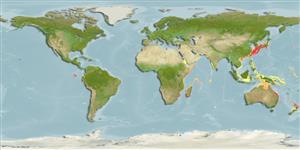Teleostei (teleosts) >
Ophidiiformes (Cusk eels) >
Carapidae (Pearlfishes) > Pyramodontinae
Etymology: Eurypleuron: Greek, eurys = long + Greek, pleura = near, the side of (Ref. 45335); owasianum: Named for its type locality (Ref. 5275).
Environment: milieu / climate zone / depth range / distribution range
Ecology
Marine; bathydemersal; depth range 1 - 455 m (Ref. 34024). Deep-water
Northwest Pacific: Japan. Pending a comprehensive study of the group, E. owasianum is restricted to Japan and tentatively refer all of the disjunct southern populations to E. cinereum, the only species name available for the complex.
Size / Weight / Age
Maturity: Lm ? range ? - ? cm
Max length : 23.6 cm TL male/unsexed; (Ref. 5275)
Eel-like, shallow body depth; dorsal fin origin about opposite anal fin origin; males with expanded parapophyses on vertebrae 5 to 18-20; lacking cardiform premaxillary teeth, pelvic fins, swim bladder rocker bone, and ventral tunic ridges on posterior swim bladder (Ref. 34024).
Uncommon species (Ref. 34024). Presumably free-living (Ref. 34024).
Life cycle and mating behavior
Maturities | Reproduction | Spawnings | Egg(s) | Fecundities | Larvae
Nielsen, J.G., D.M. Cohen, D.F. Markle and C.R. Robins, 1999. Ophidiiform fishes of the world (Order Ophidiiformes). An annotated and illustrated catalogue of pearlfishes, cusk-eels, brotulas and other ophidiiform fishes known to date. FAO Fish. Synop. 125(18):178p. Rome: FAO. (Ref. 34024)
IUCN Red List Status (Ref. 130435)
Threat to humans
Harmless
Human uses
Fisheries: of no interest
Tools
Special reports
Download XML
Internet sources
Estimates based on models
Preferred temperature (Ref.
123201): 14.1 - 23.8, mean 19.3 °C (based on 180 cells).
Phylogenetic diversity index (Ref.
82804): PD
50 = 0.7500 [Uniqueness, from 0.5 = low to 2.0 = high].
Bayesian length-weight: a=0.00102 (0.00046 - 0.00225), b=3.06 (2.88 - 3.24), in cm total length, based on all LWR estimates for this body shape (Ref.
93245).
Trophic level (Ref.
69278): 3.6 ±0.5 se; based on size and trophs of closest relatives
Fishing Vulnerability (Ref.
59153): Low vulnerability (14 of 100).
